Wheels Up: A Look at How U.S. Airports Manage Waste and Recycling
While a large number of airports across the nation have waste and recycling programs in place, they vary greatly depending on tenant agreements, hauler contracts, local regulations and other factors.
Millions of passengers flood U.S. airports each year, leaving behind waste, recycling and compostable items in bins scattered throughout airport facilities. And while a large number of airports across the nation have programs in place to handle these materials, they vary greatly depending on tenant agreements, hauler contracts, local regulations and other factors.
Other variables specific to airports include the fact that the facilities generate not just municipal solid waste (MSW), but also construction and demolition waste, green waste, food waste, domestic and international deplaned waste, lavatory waste, spill cleanup and remediation waste and hazardous waste. In essence, there are parallel waste streams that must be managed. There is waste generated within the concourse itself. There’s also the waste generated on the planes during their journeys. And then there is waste generated by airport and plane operations. “One of the main challenges airports face is working with its tenants,” says Katherine Preston, Airports Council International – North America (ACI-NA) senior director of environmental affairs. “Airlines, for example, have different haulers and different rules and regulations to follow than airports do. With thousands of flights each day, it’s hard for airlines to put programs into place when the situation on the ground is different at each airport.”
To help the aviation industry, the ACI-NA board of directors updated its environmental goals and conducted a survey to discover the current sustainability stats of 56 airports. The 2016 Benchmarking Survey revealed that 95 percent of the responding airports have a program in place to reduce, reuse or recycle materials, and more than 30 percent of responding airports have a composting program.
Onsite Waste and Recycling
Managing onsite waste and recycling is no easy feat. With waste generated at various locations, such as terminals, airfields, aircraft maintenance hangars, cargo hangars, flight kitchens, offices and airport construction projects, organization is key to ensuring that materials end up in their proper waste streams.
Haulers often work directly with airports to boost diversion rates. Texas Disposal Systems (TDS), for example, has helped Austin–Bergstrom International Airport (ABIA) more than double its diversion rates in the past year.
“This result was due to a three-pronged approach: We increased the number of receptacles in the terminal, we added recycling bins next to every trash bin and we implemented a Blue Bag program,” says Austin–Bergstrom International Airport Environmental Manager Kane Carpenter. “With our Blue Bag program, staff members place recyclables in blue bags to be sent to our centralized collection point and later transported to TDS’ facility. This process helps us ensure that all recyclables are making it to the proper destination. With these operational changes and capital expenditures, we have been able to accomplish a 100 percent diversion increase in just one year.”
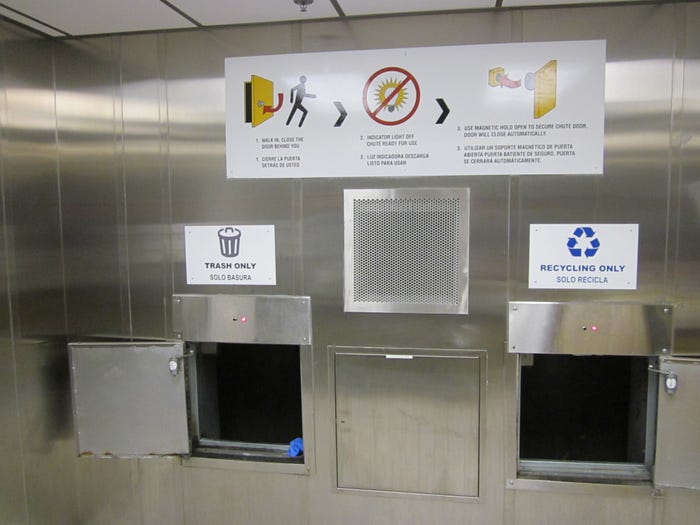
To help ABIA track the effectiveness of its waste, recycling and composting programs, TDS weighs the collected materials and relays the data back to ABIA.
Waste Management works with multiple airports across the country to divert materials from landfill via customized solutions.
“Managing waste and recycling from airports can vary greatly location by location—there is no cookie-cutter situation,” says Waste Management Strategic Account Manager Mike Pontrelli. “Waste Management offers customer solutions, which can be managed through either local or national agreements with airlines, with airport authorities through a competitive bid process and/or a combination of both depending on the location, facility and customer needs.”
Rumpke is another hauler with airport waste operations. It provides the Dayton (Ohio) International Airport with waste collection and single stream recycling collection in an effort to boost diversion rates.
“Behind the scenes, the facility recycles cardboard, mainly from shipping and receiving, airport food services, vendors and airport facilities. The foodservices team, vendors and airport facilities staff are trained to collect materials from each receptacle and transport them to the appropriate Rumpke compactor or front-load container. Rumpke’s trucks then transport those materials to its landfill or MRF,” says Rumpke Director of Corporate Communications Amanda Pratt.
To stand out from other airports and divert more material from landfill, Denver International Airport launched a composting program for paper towels.
“We did a waste audit several years ago and discovered that we had a high percentage of paper towels in our bins so we decided to do something about it. We worked with our janitorial contractor and hauler to figure out how to compost the paper towel, and now it is sent directly to a composting facility for processing,” says Denver International Airport Senior Director of Sustainability Scott Morrissey.
Diverting Food Waste from Landfill
Food waste continues to be a hot topic in the waste and recycling industry, and more businesses are ramping up food waste reduction efforts by composting food waste or donating it (or sometimes both). Airports, with their massive concourses filled with dining options, are prime generators of food waste.
Seattle-Tacoma International Airport (SEA), for example, generated 9,200 tons of waste in 2015. Of that, 70 percent of the waste came from terminal and remote areas. And more than one third of the waste generated in the terminals was food waste.
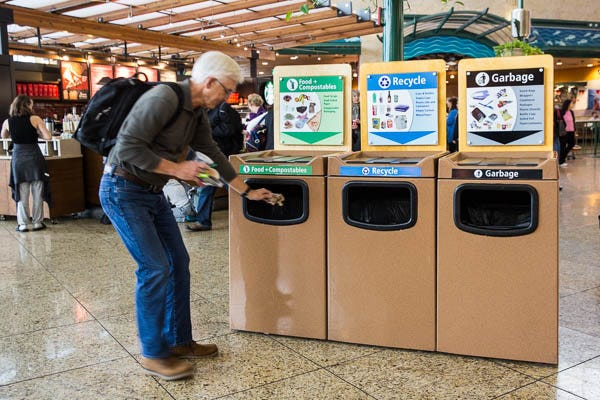
“We’ve had an active composting program in place since 2007, and we send approximately 450 tons of material to a local composting facility annually,” says Seattle–Tacoma International Airport Environmental Program Manager Jeremy Webb. “In addition to that, we have a food donation program so that airport restaurants can donate unsold food to a local food bank.”
Overall, in 2015, the concessionaires at SEA donated more than 44,000 lbs. of food through this partnership. And this year, SEA focused on increasing waste recoverability by introducing requirements to airport dining and retail tenants that limit the foodservice ware to durables, approved compostables or recyclables.
Meanwhile, earlier this year, the City of Austin implemented the Universal Recycling Ordinance Organics Diversion, the second stage of the Universal Recycling Ordinance that requires all food-permitted facilities 15,000 sq. ft. or larger to establish programs to divert organic material from landfill. And to comply with that new ordinance, ABIA is working hand-in-hand with its hauler TDS to launch a pilot composting program, which is slated to begin this month.
“We recently did a waste audit to find out what material was showing up in our bins so that we can divert more material from landfill,” says Carpenter. “Now, we are working with TDS to launch a pilot composting program so we can see how much food waste we are generating and how much we can divert. We are in the process of reaching out to our leasers and partners to inform them on what we are doing and how they can participate. Additionally, we are figuring out how we can get the waste to a centralized collection point to be taken to TDS’ composting facility, which is the most difficult part of this process.”
ABIA is also exploring the idea of a food waste donation program.
Airport food donation programs are popping up across the U.S. and leading a majority of these efforts is HMShost, a premier food and beverage provider for motorways and airports in North America.
“We’ve had a food donation program for about six years now, and we donate approximately 1.6 million lbs. of food annually to community food banks,” says HMSHost Vice President of Innovation James Schmitz. “We mostly donate food items that can be refrigerated, such as salads and sandwiches, but some locations will also donate hot items like soup.”
HMSHost follows a very stringent 24-hour shelf-life policy to ensure freshness. When items reach the 24-hour mark, they are removed from shelves to be donated. Once removed, a majority of these items will remain fresh for about four to five days. In addition to donating food items, HMSHost composts coffee grounds and recycles cooking oil, plastic wrap and shrink wrap, individual printer ink cartridges and much more.
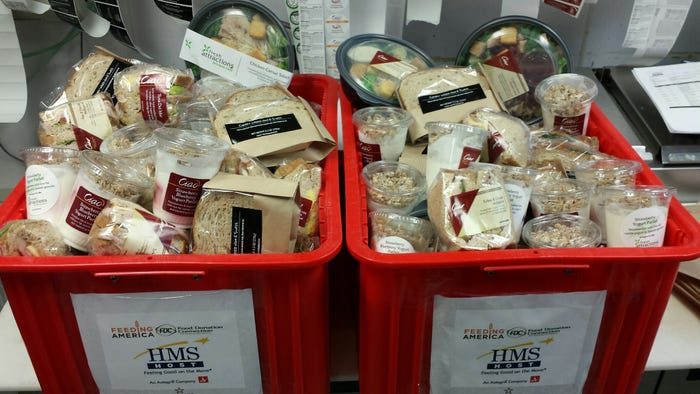
HMSHost also works with its partners on a number of sustainability efforts, from incorporating compostable cups, plates and utensils in foodservice locations to finding uses for edible-but-unattractive food items that would have otherwise been sent to landfill.
“One of our biggest efforts is done with our vendor Compass Group, which has a program called Imperfectly Delicious Produce that helps find uses for edible food that may not be ideal for table presentation,” says Schmitz. “With this program, we help divert perfectly good food from going to landfill by purchasing affordable recipe-ready produce for use in our foodservice locations.”
Denver International Airport also has a food donation program in addition to its back-of-house food scrap composting program and front-of-house office waste composting program. The airport’s food donation program, which is managed in collaboration with nonprofit Metro Caring, allows concessions and flight kitchens to donate food to a local hunger relief program.
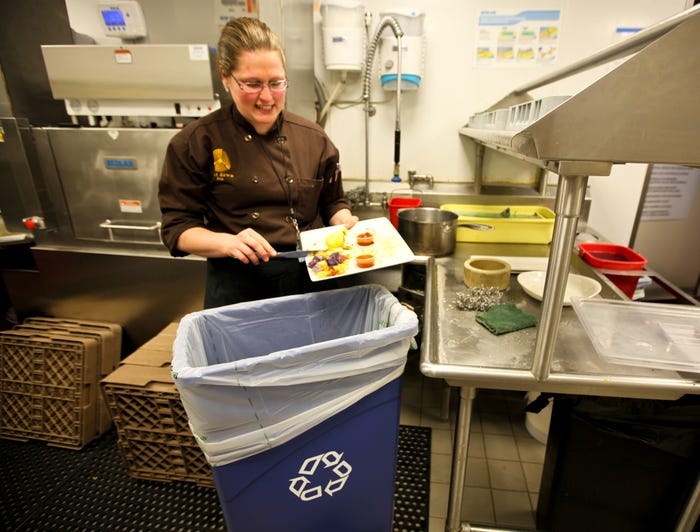
“We have donated approximately 30,000 lbs. of food to date, and we recently received a grant through the Colorado Department of Public Health and Environment that will allow us to expand to other concourse areas in our facility and more than double our collection capacity,” says Morrissey. “The expansion of this program will really be our focus for 2017 and beyond.”
Managing International and Domestic Deplaned Waste
The U.S. doesn’t have a standardized national program in place for airports to process deplaned waste, which presents challenges to haulers, airports and airlines.
Deplaned waste, which can include bottles, cans, newspaper, mixed paper, plastic cups, utensils, food waste, food-soiled paper and paper towels, makes up approximately 20 percent of airports’ total municipal solid waste (MSW) stream. And while domestic flight deplaned waste can be disposed of in airport-owned waste and recycling bins or airline-owned waste and recycling bins, international flight deplaned waste needs to be processed separately to avoid the risk of transmitting plant pests or diseases, according to the Federal Aviation Administration’s Recycling, Reuse and Waste Reduction at Airports: A Synthesis Document.
“International waste is regulated by the U.S. Department of Agriculture’s Animal and Plant Health Inspection Service (APHIS) department,” says Pontrelli. “The waste from international flights can be taken to an APHIS-approved incinerator for burning, an APHIS-approved facility for grinding and discharge into an approved sewage system or to an APHIS-approved sanitization facility, where an autoclave sanitizes the waste so it can be safely disposed of in a landfill.”
To help make waste and recycling management simple for airline crews, ABIA has placed waste and recycling collection points directly outside aircraft ramps. The biggest challenge for ABIA, according to Carpenter, is getting the airline crews to understand ABIA’s waste and recycling program and getting them to place their deplaned materials in the containers provided near the ramps.
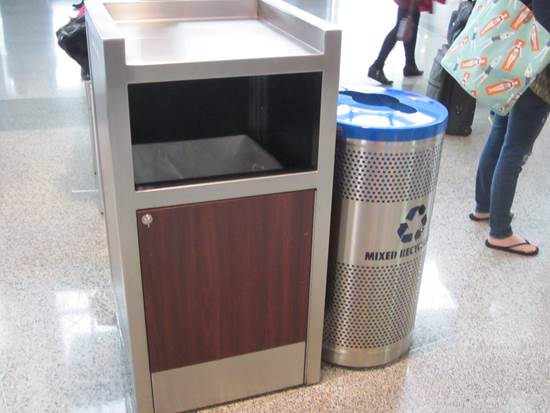
While collecting deplaned materials can be a challenge, both SEA and Dayton International Airport offer free recycling opportunities and cost-effective trash disposal to airlines in an attempt to increase airlines’ onsite waste and recycling efforts.
“We have three compactors in our facility, and we offer free trash and recycling services to our leasers,” says Dayton International Airport Environmental Scientist Mike Cross. “We encourage our leasers and the airline crews to put their recyclables in our bins because we want to divert more material from landfill. Some airlines take advantage of the recycling options by disposing of their extra magazines at the end of each month, and some leasers give us all of their cardboard waste to properly dispose of.”
Relaying Waste and Recycling Information to Both Travelers and Employees
One of the biggest challenges of managing waste and recycling in airports is educating passengers about programs and what materials can and cannot be recycled. Each airport has different programs, rules and regulations and ways of relaying information to the millions of passengers that pass through U.S. airports each year. And the rules at each airport likely differ from where passengers live.
ABIA uses signage to educate passengers on the waste and recycling options available in the airport.
“Since we are in the south, we use the slogan ‘Recycle Ya’ll’ in our signage,” says Carpenter. “The passengers seem to really love and understand the message. In addition to that, we have blue recycling bins with Saturn cutouts throughout the facility, which are easy to distinguish from our trash bins.”
SEA also utilizes signage and color-coded bins to let passengers know where they can properly dispose of trash, recyclables and compostables.
“We provide equal-opportunity recycling throughout the terminal, and we use signage with common industry standards for color coding, symbols and language,” says Webb. “In our food courts, we use signage to indicate that we compost certain items, and at security checkpoints, we offer liquid draining stations and encourage passengers to keep their empty bottles to refill at dedicated water refill stations available throughout the airport.”
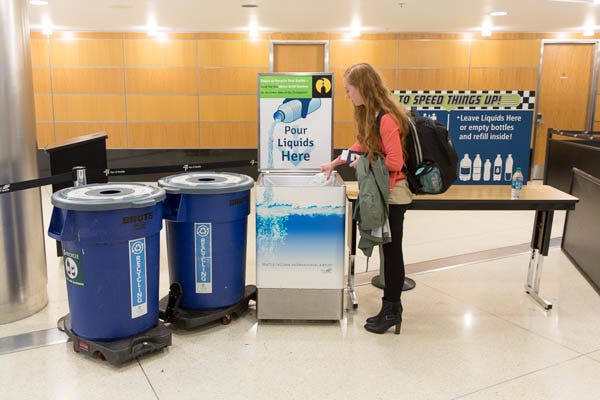
In addition to educating passengers, airport management needs to educate all employees on the programs set in place so they can help keep the programs running efficiently and accurately at all times.
“When offering companies and organizations a recycling program and other service solutions, Rumpke provides educational presentations and materials to ensure that employees, vendors, foodservices and facility management staff are educated about the program, its objectives and the facility team’s role in taking the steps necessary to make certain program goals are achieved,” says Pratt.
About the Author
You May Also Like



